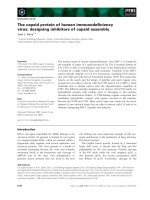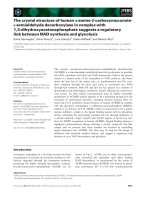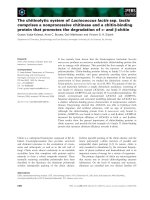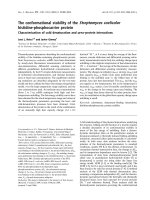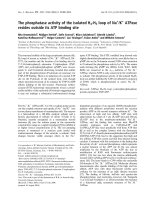Báo cáo khoa học: "THE RECOGNITION CAPACITY OF LOCAL SYNTACTIC CONSTRAINTS" ppt
Bạn đang xem bản rút gọn của tài liệu. Xem và tải ngay bản đầy đủ của tài liệu tại đây (480.59 KB, 6 trang )
THE RECOGNITION CAPACITY OF LOCAL SYNTACTIC CONSTRAINTS
Mori Rimon'
Jacky Herz ~
The Computer Science Department
The Hebrew University of Jerusalem,
Giv'at Ram, Jerusalem 91904, ISRAEL
E-mail:
Abstract
Givcn a grammar for a language, it is possible to
create finite state mechanisms that approximate
its recognition capacity. These simple automata
consider only short context information~ drawn
from local syntactic constraints which the
grammar hnposes. While it is short of providing
the strong generative capacity of the grammar,
such an approximation is useful for removing
most word tagging ambiguities, identifying many
cases of iU-fonncd input, and assisting efficiently
in othcr natural language processing tasks. Our
basic approach to the acquisition and usage of
local syntactic constraints was presented clse-
whcre; in this papcr we present some formal and
empiric-,d results pertaining to properties of the
approximating automata.
1. Introduction
Parsing is a process by which an input sentence
is not only recognized as belonging to the lan-
guage, but is also assigned a structure. As
[l]erwick/Wcinbcrg 84] commcnt, recognition
per se (i.e. a weak generative capacity analysis) is
not of much value for a theory of language
understanding, but it can be useful "as a diag-
nostic". We claim that if an cfficient recognition
procedure is availat~le, it can be tnost valuable as
a prc-parsing reducer of lcxical ambiguity (espe-
cially, as [Milne 86] points out, for detcnninistic
parsers), and cvcn more useful in applications
where full parsing is not absolutely required -
e.g. identification of iU-formed inputs in a text
critique program. Still weaker than recognition
procedures are 'methods which approximate the
recognition capacity. This is the kind of methods
that we discuss in this paper.
More specifically, we analyze the recognition
capacity of automata based on local (short
context) considerations. In [Herz/Rimon 91] we
prescnted our approach to the acquisition and
usage of local syntactic constraints, focusing on
its use for reduction of word-level ambiguity.
After briefly reviewing this method in section 2
below, we examine in more detail various char-
acteristics of the approximating automata, and
suggest several applications.
2. Background: Local Syntactic
Constraints
Let S = Wi, , W• be a sentence of length N,
{Wi} being the words composing the sentence.
And let ti t• be a tag image corresponding to
the sentence S, {ti} belonging to the tag set T -
the set of word-class tags used as terminal
symbols in a given grammar G. Typically,
M=N,
but in a more general environment we
allow M > N . This is useful when dealing with
languages where morphology allows cliticization,
concatenation of conjunctions, prepositions, Or
determiners to a verb or a noun, etc.; in gram-
mars for l lebrew, for example, it is convenient
J M. Rimon's main atfiliafion is the IBM Scientific Center, i laifa, Israel, E-mail:
2 j. I Icrz was partly supported by the I.eihniz ('enter for R.esearch in Computer Science, the ! lebrew University,
and by the Rau foundation of the Open University.
155 -
to assume that a preliminary morphological
phase separated word-forms to basic sequences
of tags, and then state syntactic rules in terms of
standard word classes.
In any case, it is reasonable to assume that the
tag image it IM cannot be uniquely assigned.
Fven with a coarse tag set (e.g. parts of speech
with no features) many words have more than
one interpretation, thus giving rise to exponen-
tially many tag images for a sentence. 3
Following [Karlsson 90], we use the term
cohort
to refer to the set of lcxicaUy valid readings of a
given word. We use the term
path
to refer to a
sequence of M tags (M~ N) which is a tag-
image corresponding to the words W, , WN of
a given sentence S. This is motivated by a view
of lexical mnbiguity as a graph problem: we try
to reduce the number of tentative paths in
ambiguous cases by removing arcs from the Sen-
tence Graph (SG) - a directed graph with ver-
tices for all tags in all cohorts of the words in
the given sentence, and arcs connecting each tag
to ~dl tags in the cohort which follows it.
The removal of arcs and the testing of paths for
validity as complete sentence interpretations are
done using local constraints. A local constraint
of length k on a given tag t is a rule allowing or
disaUowing a sequence of k tags from being in
its right (or left) neighborhood in any tag image
of a sentence. In our approach, the local con-
straints are extractcd from the grammar (and this
is the major aspect distinguishing it from some
other short context methods such as [Beale 881,
[DeRose 88], [Karlsson 90], [Katz 851,
[Marcus 80], [Marshall 831, and [Milnc 861).
For technical convenience we add the symbol
"$ <" at the beginning of tag images and "> $~ at
the etad. Given a grammar G (wlfich for the time
being we assume to be an unrestricted context-
free phrase structure grammar), with a:set T of
terminal symbols (tag set), a set V of variables
(non-terminals, among which S is the root vail-
able for derivations), and a set P of production
rules of the form A a, where A is in V and a
is in (VUT)* , we define the Right Short
Context of length k of a terminal t (tag):
SCr (t,k) for t in T and for k = 0,1,2,3
tz I z ~ T*,
Izl=k or Izl
< k
if
"> $' is the last tag in z,
and there exists a derivation
S = > atz// (a,//~ (V U T)* )
The l.eft Short Context of length k of a tag t rel-
ative to the grammar G is denoted by SCI (t,k)
and defined in; a similar way.
It is sometimes useful to define
Positional
Short
Contexts. The definition is similar to the above,
with a restriction that t may start only in a given
position in a tag image of a sentence.
The basis for the automaton Which checks a tag
stream (path) for validity as a tag-image relative
to the local constraints, is the function next(t),
which for any t in T defines a set, as follows: :
next (t) = { z I tz E SCr (t,l)
}
In [Ilerz/Rimon 911 we gave a procedure for
computing next(t) from a given context free
grammar, using standard practices of parsing of
formal languages (see [Aho/Ulhnan 72]).
3. Local Constraints Automata
We denote by LCA(I) the simple finite state
automaton which uses the pre-processed
{next(t)} sets to check if a given tag stream
(path) satisfies the SCr(t,l) constraints.
In a similar: manner it is possible to define
LCA(k), relative to the short context of length k.
We denote by L the language generated by the
3 Our studies of modern written ! lebrew suggest that about 60% of the word-forms in running texts are ambiguous
with respect to a basic tag set, and the :average number of
possible readings
of such
word-forms is
2.4. Even
when counting only "natural readings', i.e. interpretations which are likely to occur in typical corpora, this
number is quite large, around 1.8 (it is somewhat larger for the small subset of the most common words).
156 -
underlying grammar, and by L(k) the language
accepted by the automaton LCA(k). The fol-
lowing relations hold for the family of automata
(LCA(i)}:
L(I) _~ L(2) _~ ~ L
"llfis guarantees a security feature: If for some i,
I.CA(i) does not recognize (accept) a string of
tags, then this string is sure to be illegM (i.e. not
in 1.). On the other hand, any LCA(k) may rec-
ognize sentences not in L (or, from a dual point
of view, will reject only part of the illegal tag
images). The important question is how tight are
the inclusion relations above - i.e. how well
LCA(k) approximates the language I in partic-
ular we are interestcd in LCA(I).
There is no simple analytic answer to tiffs ques-
tion. Contradictory forces play here: the nature
of the language c.g a rigid word order and
constituent order yield stronger constraints; the
grain of the tag set better refined tags (dif-
ferent languages may require different tag sets)
help express refined syntactic claims, hence more
specific constraints, but they "also create a greater
level of tagging ambiguity; the size of the
grammar a larger grammar offers more infor-
mation, but, covering a richer set of structures, it
• allows more tag-pairs to co-occur; etc.
It is interesting to
note
that for l lebrew, short
context methods are most needed because of the
considerable ambiguity at the lexical level, but
their cll~:ctiveness suffers from the rather free
word/constituent order.
Finally, a comment about the computational
efficiency of the LCA(k) automaton. The time
complexity of checking a tag string of length n
using I,CA(k) is at most O(n x k x loglTI),
while a non-deterministic parser for a context
free grmntnar may require O(n3x IGI2). (IT] is
the size of the tag set, IGI is the size of the
grammar). The space complexity of l,CA(k) is
proportionM to ]7] k÷~ ; this is why otfly truly
short contexts should be used.
Note that for a sentence of length k, the power
of LCA(k) is idcnticM to the weak generative
capacity of the full underlying grammar. But
since the size of sentences (tag sequences) in L is
unbounded, there is no fixed k which suffices.
4. A Sample Grammar
To illustrate claims made in the sections below,
we will use the following toy grammar of a small
fragment of English. Statements about the cor-
rectness of sentences etc., are of course relative
to this toy grammar.
The tag set T includes: n (noun), v (verb), det
(determiner), adj ( adjective ) and prep (preposi-
tion). The context free grammar G is:
S > $< NP VP >$
NP > (det) (adj) n
NP > NP PP
PP > prep NP
VP > v NP
VP > VP
PP
To extract the local constraints from this
grammar, we first compute the function next(t)
for every tag t in T, and from the resulting sets
we obtain the graph below, showing valid pairs
in the short context of length 1 (again, validity is
relative to the given toy grammar):
>$
This graph, or more conveniently the table of
"valid neighbors" below, define the LCA(I)
automaton. The table is actually the union of
the SCr(t,l) sets for all t in T, and it is derived
directly from the graph:
$< det adj n prep adj
$< adj v det prep n
$< n v adj n prep
det adj v n n v
det n prep det n >$
- 157 -
5. A "Lucky Bag" Experiment
Consider the following sentence, which is in the
language gcncratcd by grammar G of section 4:
(1) Thc channing princess kissed a frog.
The unique tag image corresponding to this sen-
tence is: [ $ <, dot,
adi, n, v,
det, n, > $ ].
Now let us look at the 720 "random inputs" gen-
erated by permutations of the six words in (i),
and the set of corresponding tag images.
Applying I.CA(I), only two tag images are
rccog~.ed as valid: [ $ <, det, adj, n, v, det, n,
>$ ], and [ $<, dct, n, v, dot, adj, n, >$ ].
These are exactly the images corresponding to
the eight syntactically correct sentences (relative
to G),
(la-b) The/a charming princess kissed a/the frog.
(lc-d) The/a chamfing frog kissed a/the princess.
(lc-t') The/a princess kissed a/the charming frog.
(lg-h) The/a frog kissed a/the charming princess.
This result is not surprising, given the simple
scntence and toy grammar. (In general, a
grammar with a small number of rules relative to
the size of the tag set cannot produce too many
valid short contexts). It is therefore interesting
to examine another example, where each word is
associated with a cohort of several interpreta-
tions. We borrow from [llcrz/Rimon 9.1]:
(2) All old people like books about fish.
Assuming the word tagging shown in section 6,
there are 256 (2 x 2 x 2 x 4 x 2 x 2 x 2) tentative
tag hnages (paths) for this sentence and for each
of its 5040 permutations. This generates a very
htrge number of rather random tag images.
Applying LCA(I), only a small number of
hnages are rccogtfizcd as potentially valid.
Among them are syntactically correct sentences
such as:
(2a) Fish like old books about all people.
,and only less than 0.1% sentences which are
locally valid but globally incorrect, such as:
(2b) * Old tish all about books like people.
(tagged as [$ <, n, v, n, prep, n, v, n, > $]).
These two examples do not suggest any kind of
proof, but they well illustrate the recognition
power of even the least powerful automaton in
the {LeA(i)} family. To get another point of
view, one may consider the simple formal lan-
guage L consisting of the strings
{ar"b m}
for
I < rn, which can be generated by a context-free
grammar (} over T = {a, b}. I.CA(I) based on
(; will recognize all strings of the form
(a'b ~}
for
1 <j,k,
but none of the very many other strings
over T. It can be shown that, given arbitrary
strings of length n over T, the probability that
LeA(I) will not reject strings not belonging to L
is proportional to n/2", a term which tends
rapidly to 0. This is the over-recognition margin.
6. Use of LeA in Conjunction with a
Parser
The number of potentially valid tag images
(paths) for a given sentence can be exponential
in the length of the sentence if all words are
ambiguous. It is therefore desirable to filter out
invalid tag images before (or during) parsing.
To examine the power of LCAs as a pre-parsing
fdter, we use example (2) again, demonstrating
lexical ambiguities as shown in the chart below.
The chart shows the Reduced Sentence Graph
(RSG) - the original SG from which invalid arcs
(relative to the SCr(t,l) table) were removed.
ALL OLD PEOPLE LIKE BOOKS ABOUT FISH
det ~adj ~n ~v
- ~
n ~prep >n
n n ) v__prepj e v >$
n
We are left with four valid paths through the
sentence, out of the 256 tentative paths in SG.
Two paths represent legal syntactic interpreta-
tions (of which one is "the intended" meaning).
The other two are locally valid but globally
incorrect, having either two verbs or no verb at
- 158 -
all, in contrast to the grammar. SCr(t,2) would
have rejected one of the wrong two.
Note that in this particular example the method
was quite effective in reducing sentence-wide
interpretations (leaving an easy job even for a
deterministic parser), but it was not very good in
individual word tagging disambiguation. These
two sub-goals of raging disambiguation
reducing the number of paths and reducing
word-level possibilities - are not identical. It is
possible to construct sentences in which all
words are two-way ambiguous and only two dis-
joint paths out of the 2 N possible paths are legal,
thus preserving all word-level ambiguity.
We demonstrated the potential of efficient path
reduction for a pre-parsing filter. But short-con-
text techniques can also be integrated into the
parsing process itself. In this mode, when the
parser hypothesizes the existence of a constit-
uent, it will first check if local constraints do not
rule out that hypothesis. In the example above,
a more sophisticated method could have used
the fact that our grammar does not allow verbs
in constituents other than VP, or that it requires
one and only one verb in the whole sentence.
The motiwttion for this method, and its princi-
ples of operation, are similar to those behind dif-
ferent tecimiques combining top-down and
bottom-up considerations. The performance
gains depend on the parsing technique; in
general, allowing early decisions regarding incon-
sistent tag assignments, based on information
Which may be only implicit in the grammar,
offers considerable savings.
7. Educated Guess of Unknown Words
Another interesting aid Which local syntactic
constraints can provide for practical parsers is
"an oracle" which makes "educated guesses ~
about unknown words. It is typical for language
analysis systems to assume a noun whenever an
unknown word is encountered. There is sense in
tiffs strategy, but the use of LCA, even LCA(I),
can do much better.
To illustrate this feature, we go back to the prin-
cess and the frog. Suppose that an adjective
unknown to the system, say 'q'ransylvanian" was
used rather than "charming" in example (1),
yielding the input sentence:
(3) The Transylvanian princess kissed a frog.
Checking out all tags in T in the second position
of the tag image of this sentence, the only tag
that satisfies the constraints of LCA(1) is
adj.
8. "Context Sensitive" Spelling
Verification
A related application of local syntactic con-
straints is spelling verification beyond the basic
word level (which is, in fact, SCr(t,0) ).
Suppose that while typing sentence (1), a user
made a typing error and instead of the adjective
"charming u wrote "charm" (or
"arming",
or any
other legal word which is interpreted as a noun):
(4) The charm princess kissed a frog.
This is the kind of errors* that a full parser
would recognize but a word-based spell-checker
would not. But in many such cases there is no
need for the "full power (and complexity) of a
parser; even LCA(I) can detect the error. In
general, an
LCA
which is based on a detailed
grammar, offers cheap and effective means for
invalidation of a large set of ill-formed inputs.
Here too, one may want to get another point of
view by considering the simple formal language
L = {ambm}.
A single typo results in a string
with one "a', changed for a "W, or vice versa.
Since LCA(i) recognizes strings of the form
{aJb ~}
for 1
<_j,k,
given arbitrary strings of length
n over T = (a, b}, LCA(I) will detect "all but
two of the n single typos possible - those on the
borderline between the a's and b's.
Remember that everything is relative to ~ the toy
grammar used
throughout this paper. Hence, although "the
charm princess" may be a perfect noun phrase, it is illegal relative to our grammar.
- 159 -
9. Assistance to Tagging Systems
Taggcd corpora are important resources for
many applications. Since manual tagging is a
slow and expensive process, it is a common
approach to try automatic hcuristics and resort
to user interaction only when there is no dccisive
information. A well-built tagging system can
"learn" and improve its performance as more
text is processed (e.g. by using the already tagged
corpus as a statistical knowledge base).
Arguments such as those given in sections 7 and
8 above suggest that the use of local constraints
can resolve many tagging ambiguities, thus
incrcasing the "specd of convergence" of an auto-
matic tagging system• This seems to be true even
for the rather simple and inexpensive I,CA(I) for
laaaguagcs with a relatively rigid word order. For
related work cf. [Grccne/Rubin 71], I~Church
88], [l)cRose 88], and [Marshall 83].
10. Final Remarks
To make our presentation simpler, we have
limited thc discussion to straightforward context
free grammars. But the method is more gcnerzd.
It can, for example, he extended to Ci:Gs aug-
mented with conditional equations on features
(such as agrccmcnt)- cither by translathag such
grammars to equivalent CFGs with a more
detailed tag set (assuming a finite range of
feature values), or by augmenting our a:utomata
with conditions on arcs. It can also be extended
for a probabilistic language model, generating
probabilistic constraints on tag sequences from a
probabilistic CFG (such as of [Fujisaki et ",3.1.
89]).
Perhaps more interestingly, the method can be
used even without an underlying grammar, if a
large corpus and a lexical analyzer (which sug-
gests prc-disambiguatcd cohorts) are available.
This variant is based on a tcchnique of invali-
dation of tag pairs (or longer sequences) which
satisfy certain conditions over the whole lan-
guage L, and the fact that L can be approxi-
matcd by a large corpus. We cannot elaborate
on this extcnsion here.
References
[
Aho/UIIman 72] Alfred V. Aho and Jeffrey D.
Jllman. 7"he Theory of Parsing, Translation and
Compiling. Prentice-! lall, 1972-3.
f
Bcalc 88] Andrew David 13eale. I~exicon and
;rammar in Probabilistic Tagging of Written
Fnglish. Proc. of the 26th Annual Meeting of the
ACL, Buffalo NY, 1988.
[Berwick/Wcinberg 84] Robert C. Berwick and
Amy S. Weinberg. "/'he Grammatical Basis of
Linguistic Performance, The M IT Press, 1984.
[Church 88] Kenneth W. Church. A Sto-
chastic Parts Program and Noun Phrase Parser
for Running Text. Proc. of the 2nd A CL conf.
on Applied Natural Language Processing. 1988.
[DcRose 88] Steven J. l)eRose. Grammatical
Category Dnsambiguation by Statistical Opti-
mization. Computational Linguistics, vol. 14, no.
1, 1988.
Fujisaki et al. 89] T. Fujisaki, F. Jelinek, J.
~'ocke, E. Black, T. Nishimo. A Probabilistic
Parsing Method for Sentence l)isambiguation.
Proc. of the Ist International Parsing Workshop,
Pittsburgh, June 1989.
~
;rcene/Rubin 71] Barbara Greene and Gerald
ubin. Automated Grammatical Tagging of
ll:~ish. Technical Report, Brown Umversity,
llerz/Rinnon 91] Jacky llerz and Mori Rimon.
,ocal Syntactic Constraints. Proc. of the 2nd
International Workshop on Parsing Technologies,
Cancun, February 1991.
Karlsson 90] Fred Karlsson. Constraint
rammar as a Framework for Parsing Running
Text. The 13th COLING Conference, Helsinki,
1990.
[Katz 85] Slava Katz. Recursive M-gram
l_,an-
guage
Model Via Smoothing of Turing Formula.
IBM Technical Disclosure Bulletin, 1985.
~
larcus 80] Mitchell P. Marcus. A Theo~ of
ntactic Recognition for Natural Language, l'he
IT Press, 1980.
[Marshall 83] lan Marshall. Choice of Gram-
matical Word-Class Without Global Syntactic
Analysis: Tagging Words in the LOB Corpus.
Computers in the llumanities, vol. 17, pp.
139-150, 1983.
Milne
86] Robert Milne. Resolving Lexical
mbiguity in a Deterministic Parser. Computa-
tionalLinguistics, vol. 12, no. 1, pp. 1-12, 1986•
- 160-


